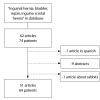Diagnosis and treatment of inguinal hernia of the bladder: a systematic review of the past 10 years
- PMID: 30487042
- PMCID: PMC6134980
- DOI: 10.5152/tud.2018.46417
Diagnosis and treatment of inguinal hernia of the bladder: a systematic review of the past 10 years
Abstract
Objective: Inguinoscrotal hernia (ISH) of the bladder is a rare condition involved in less than 4% of inguinal hernias. In most cases, it occurs to men older than 50 years who are overweight. Little is known about the subject and mainly based on case reports. When undiagnosed, it may be associated with bladder injuries during hernia repair. There is also no consensus on the ideal repair technique to use. The aim of the study is to evaluate the particularity of the management of the inguinal herniation of the bladder in term of diagnosis, choice and results of treatments.
Methods: A Prisma systematic review of the literature was performed over the last 10 years using a database. We selected 51 articles including 64 patients with ISH of the bladder.
Results: ISH of the bladder mainly occurred in overweight men aged over 50 years (Body Mass Index >30). Symptoms were reported for 76% of the patients (n=49), including inguinal swelling 60% of cases (n=38), lower urinary tract symptoms (48%), pain (40%) and a reduction of an inguinal mass after voiding (12.7%). Diagnosis was incidental on imaging for 7 patients, during inguinal repair surgery for 8, or on imaging performed following symptoms for the remaining 49 patients. Surgical repair was reported for 46 patients (71%) including various procedures as open surgery (80%) and laparoscopic approaches (20%). Excellent short term results were reported.
Conclusion: ISH of the bladder seams more likely to occur with patients suffering from lower urinary tract obstruction and best diagnosed with a computerized tomography scan. Various surgical techniques are reported.
Conflict of interest statement
Figures
References
-
- Sarr A, Ondo CZ, Sow Y, Fall B, Thiam A, Sine B, et al. Inguinal hernia of the bladder: about 8 cases. Pan Afr Med J. 2015;22:7. https://doi.org/10.11604/pamj.2015.22.7.7474. - DOI - PMC - PubMed
Publication types
LinkOut - more resources
Full Text Sources
Miscellaneous


